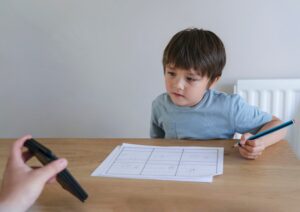What is emergent language?
Emergent language is the language skills that kiddos acquire over their first three years of life (up to 36 months).
So, what skills are we talking about here?
What do we hear?
Vocalizations… These consist of skills such as cooing (i.e. primarily producing vowel sounds) and then babbling (i.e. utilizing CV, CVCV, and CVCVCV syllable structures such as “bababa”).
Vocalizations are different than verbalizations in that verbalizations are “words” used to EXPRESS something whereas vocalizations are productions where the child is simply demonstrating use of his or her voice. When utilizing verbalizations, children also demonstrate various pragmatic functions. They are as follows:
- To request,
- To refuse/reject,
- To comment,
- To greet or farewell,
- And the list goes on and on…
Single Words à Combining Words
Once your child has produced single words for a variety of pragmatic functions, you should start providing prompts and models to “add on” to those utterances to make word combinations. For example, if your child produces, “More,” during mealtime, you can prompt him/her to say, “More milk.”
What do we see?
As your child develops, you will begin to notice joint attention. Joint attention is when you and your child are looking/focusing on the same thing (i.e. you are sharing the attention of an item). During times of joint attention, you want to provide models of appropriate types of play, outlined below, and numerous language structures and functions.
Hierarchy of Play:
- Sensorimotor/Exploratory Play. This is where the infant is physically holding and exploring his/her toys—grasping, putting it in his/her mouth, licking, banging rubbing, etc.
- Relational/Non-Functional Play. This is a “step up” from exploratory play in that you see your child realizing that pieces of toys “fit together” (e.g. puzzles, shape sorters, etc.) or can stack up, knock down, etc.
- Functional/Conventional Play. This step is where you begin to observe your child’s imagination through “pretend play.” For example, they may rock their baby doll or stuffed animal, stir a spoon in a play mug or bowl, kiss their beloved items, etc.
- Symbolic Play. This takes functional play even a step farther. This step requires an agent and an action. For example, your child may “feed” his/her teddy bear a piece of play-pizza or give it a drink of his/her bottle.
This information regarding play was retrieved from: http://www.indiana.edu/~cogdev/labwork/assessmentofplay.pdf
One type of play that was not specifically outlined above is parallel play. This is a type of play that I highly recommend in the home setting as this setting is very conducive to doing so with parents, siblings, grandparents, cousins, etc. Parallel play occurs when a child and a peer, or adult, are playing side-by-side but not exactly interacting with one another. In speech/language therapy, I use this as an opportunity to observe their play skills and to utilize some of the tips provided below…
After all that, how can we promote these skills at home?
- “Narrate your Life”—Sequence and identify your actions aloud for your child, whether during parallel play or during everyday tasks (e.g. “I am going to dump all of the sand on top of the truck” or “I am going to get the cake at the store and then go home”) and label your belongings, tools, etc. so that your child is exposed to everyday language and vocabulary terms.
- Sing, dance, and rhyme—Fingerplay songs like the “Itsy, Bitsy Spider” are great for facilitating eye contact and joint attention. Singing and dancing is a fun activity to do together in order to facilitate following directions (e.g. “Shake your arms”) as well as to be exposed to new vocabulary items (e.g. body parts, actions, etc.) in your directions as well as in the song lyrics themselves. Rhyming lyrics facilitate overall phonemic (i.e. sound) and phonological (i.e. syllables and words) awareness, too!
- Complex Sentence Structures are OK!— Don’t feel the need to use “baby talk” or “dumb down” what you’re saying to your child with emerging language. They can handle complex sentences. The more language exposure, the better!
- BOMBARDMENT— I use this term A LOT… What I mean by this is to provide an ABUNDANCE of models of language—auditory AND visual bombardment. Bombard him or her with vocabulary… label everything!!

